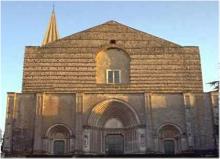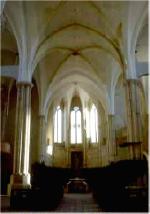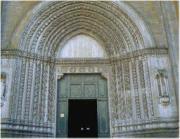
Todi -
The Church of San Fortunato
 |
| Chiesa di S. Fortunato |
The
church of San Fortunato was built by the Lesser Franciscan friars and once belonged to the Vallombrosa order. A first phase of construction got underway between 1292 and 1328, with the completion of the choir and two of the four arcades. The second stage of building lasted from 1408 until 1464. Although work on the facade lasted from 1415 to 1458, it was never completed. The fine main entrance (1420-36) is carved with scenes from the Last Judgement that are almost of the same standard as those of the entrance of the Duomo in Orvieto. The two stone lions that greet the visitor at the top of the steps leading to San Fortunato come from the previously existing Romanesque church. The design of the interior, with three naves of the same height, is a northern feature that appears in Umbria also in the churches of San Domenico and San Lorenzo in Perugia. But the massive polygonal columns and ogival vaulting of San Fortunato make it easily the grandest example of this kind of architecture in the whole of central Italy.
 |
| Interno Chiesa S. Fortunato |
The lateral chapels, included in the design of the church from the beginning (as at Santa Trinità in Florence), are an odd feature in that they largely appeared in Italy during the Renaissance. Usually they were sold to wealthy families to use as tombs, thereby raising precious funds for the building of the church itself. Slight differences are visible, particularly in the first couple of columns and in the smaller windows of the first two arcades, that indicate the two different building phases. A Gothic holy water basin stands at the first column on the right. In the fourth chapel on the same side there is a fresco, 'Madonna with Child and Angels', by Masolino da Panicale (1432). The fifth chapel is decorated with frescoes of the Giotto school from the first half of the 14th century. The following chapel was not included in the original designs of the church and was formerly the capitular chamber. It contains late 14th century frescoes by Nicola Vannucci di Todi. A 14th century pulpit has been placed above the entrance to the chapel. The stalls of the wooden polygonal choir are by Antonio Maffei di Gubbio, from 1590. The fifth chapel on the left contains more Giotto school fresco work, while the third chapel is entirely decorated by Andrea Polidori (1618). The first column on the left stands on two capitals placed one above the other. The upper capital was probably recycled from the previously existing church and functions as a holy water basin.
 |
| Portale Chiesa S. Fortunato |
The crypt beneath contains the tomb of Jacopone da Todi (1230-1306), the fervent Franciscan friar who was one of St Francis' earliest companions. As well as being the attributed author of the 'Stabat mater dolorosa', in Latin, Jacopone's 'Laudi' make him the first poet to write also in the vulgar Italian language. His continued disagreement with the Vatican eventually led to his excomunication. Obliged to seek refuge in the convent of San Lorenzo at Collazzone, Jacopone died on Christmas Eve 1306.
© Copyright 2001-2025
by Umbriaonline.com
SCG Business Consulting S.a.s. di Giacomelli E. & C. - Internet Advertising Division - © 2001-2025 All Rights Reserved - P.IVA 01675690562


